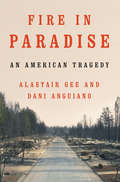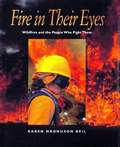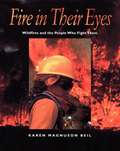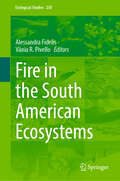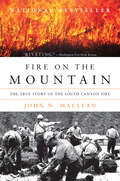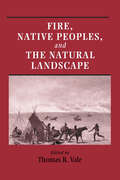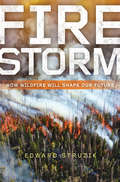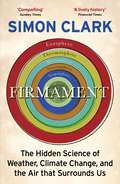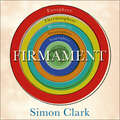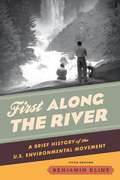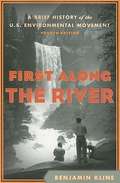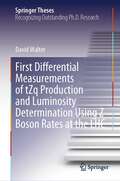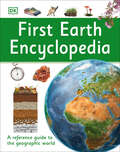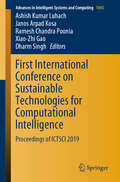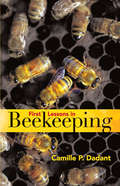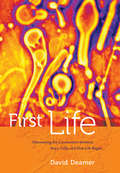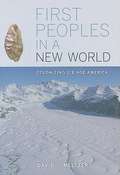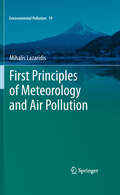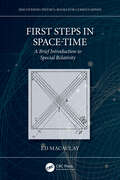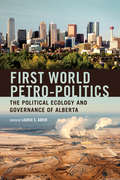- Table View
- List View
Fire in Paradise: An American Tragedy
by Alastair Gee Dani AnguianoThe harrowing story of the most destructive American wildfire in a century. There is no precedent in postwar American history for the destruction of the town of Paradise, California. On November 8, 2018, the community of 27,000 people was swallowed by the ferocious Camp Fire, which razed virtually every home and killed at least 85 people. The catastrophe seared the American imagination, taking the front page of every major national newspaper and top billing on the news networks. It displaced tens of thousands of people, yielding a refugee crisis that continues to unfold. Fire in Paradise is a dramatic and moving narrative of the disaster based on hundreds of in-depth interviews with residents, firefighters and police, and scientific experts. Alastair Gee and Dani Anguiano are California-based journalists who have reported on Paradise since the day the fire began. Together they reveal the heroics of the first responders, the miraculous escapes of those who got out of Paradise, and the horrors experienced by those who were trapped. Their accounts are intimate and unforgettable, including the local who left her home on foot as fire approached while her 82-year-old father stayed to battle it; the firefighter who drove into the heart of the inferno in his bulldozer; the police officer who switched on his body camera to record what he thought would be his final moments as the flames closed in; and the mother who, less than 12 hours after giving birth in the local hospital, thought she would die in the chaotic evacuation with her baby in her lap. Gee and Anguiano also explain the science of wildfires, write powerfully about the role of the power company PG&E in the blaze, and describe the poignant efforts to raise Paradise from the ruins. This is the story of a town at the forefront of a devastating global shift—of a remarkable landscape sucked ever drier of moisture and becoming inhospitable even to trees, now dying in their tens of millions and turning to kindling. It is also the story of a lost community, one that epitomized a provincial, affordable kind of Californian existence that is increasingly unattainable. It is, finally, a story of a new kind of fire behavior that firefighters have never witnessed before and barely know how to handle. What happened in Paradise was unprecedented in America. Yet according to climate scientists and fire experts, it will surely happen again.
Fire in Their Eyes: Wildfires and the People Who Fight Them
by Karen Magnuson BeilDepicts the training, equipment, and real-life experiences of people who risk their lives to battle wildfires, as well as people who use fire for ecological reasons.
Fire in Their Eyes: Wildfires and the People Who Fight Them
by Karen Magnuson BeilWhat drives some people to stand in the path of a wall of flame? Who are these brave, foolhardy, visionary firefighters? This intimate look at the elite groups that fight wildfires explores the trials, tragedies, and triumphs of these courageous few as they battle wilderness blazes from Alaska to Maine. From the grueling training of a smokejumper class in Montana, through harrowing fights with some up-close-and-personal wildfires, to a group of inspired conservationists who use fire as a tool for preservation, Karen Magnuson Beil takes readers where only a few have ventured--into the heart of one of nature's most destructive and unpredictable forces: fire.
Fire in the Sky: The Air War in the South Pacific
by Eric M. BergerudThis book explores the technology, tactics, 3-D battlefield, leadership, living conditions, medical challenges and morale of the combatants during WWII in the air over the Pacific.
Fire in the South American Ecosystems (Ecological Studies #250)
by Alessandra Fidelis Vânia R. PivelloThe incidence of anthropogenic fires in South America has increased lately, and fire effects on the biodiversity and ecosystem services are of great concern. On the other hand, natural fires have been present in the continent for thousands of years, acting as an evolutionary driver of vegetation and fauna. Therefore, several ecosystems in South America are fire-prone due to their evolutionary history, while those that have not evolved under frequent fires are fire-sensitive. At the same time, as humans increase fire frequency in some environments they try to banish fire from others, and such anthropogenic fire regimes have enormous consequences for biota, ecosystem services and the environment. This book will address the various South American ecosystems that benefit from the presence of fire, but also those that are harmed by fire. The effects of fire on plant and animal biodiversity of the main South American ecosystems will be presented and discussed considering current trends in climate and land use change, bringing understanding about when and how fire should or should not be used to benefit nature and humans. Options for fire planning and management will be highlighted, especially considering the reduction of wildfire risk and the conservation of biodiversity and natural resources. This broad comprehension of the fire issue in South America will support wise decisions by environmental analysts, conservation managers and public policy makers.
Fire on the Mountain: The True Story Of The Sourth Canyon Fire
by John N MacleanIn 1994, a wildfire on Colorado's Storm King Mountain was wrongly identified at the outset as occurring in South Canyon.This unintentional, seemingly minor human error was the first in a string of mistakes that would be compounded into one of the greatest tragedies in the annals of firefighting. Before it was done, fourteen courageous firefighters—men and women, hotshots, smoke jumpers, and helicopter crew—would lose their lives battling the deadly so-called South Canyon blaze.John N. Maclean's award-winning national bestseller Fire on the Mountain is a stunning reconstruction of the killer conflagration and its aftermath—a page-turning true adventure of nature at its most unforgiving, and a powerful, indelible portrait of a unique breed of heroes who regularly and without question place their lives on the line.
Fire, Native Peoples, and the Natural Landscape
by Thomas ValeFor nearly two centuries, the creation myth for the United States imagined European settlers arriving on the shores of a vast, uncharted wilderness. Over the last two decades, however, a contrary vision has emerged, one which sees the country's roots not in a state of "pristine" nature but rather in a "human-modified landscape" over which native peoples exerted vast control.Fire, Native Peoples, and the Natural Landscape seeks a middle ground between those conflicting paradigms, offering a critical, research-based assessment of the role of Native Americans in modifying the landscapes of pre-European America. Contributors focus on the western United States and look at the question of fire regimes, the single human impact which could have altered the environment at a broad, landscape scale, and which could have been important in almost any part of the West. Each of the seven chapters is written by a different author about a different subregion of the West, evaluating the question of whether the fire regimes extant at the time of European contact were the product of natural factors or whether ignitions by Native Americans fundamentally changed those regimes.An introductory essay offers context for the regional chapters, and a concluding section compares results from the various regions and highlights patterns both common to the West as a whole and distinctive for various parts of the western states. The final section also relates the findings to policy questions concerning the management of natural areas, particularly on federal lands, and of the "naturalness" of the pre-European western landscape.
Fires Next Time: Understanding Australia's Black Summer
by Peter ChristoffFollowing a three-year drought and during the hottest and driest year on record, a flume of scorching air set the Australian continent aflame. The Black Summer fires were unprecedented. Over six months in 2019-20 they burned more than 24 million hectares of Australia's southern and eastern forests - one of the largest areas burnt anywhere on Earth in a single event. The fires killed 33 people and 430 more died as an indirect consequence and they caused unfathomable harm to native species. Their economic ramifications were extensive and enduring. State and federal governments and communities were under-prepared for that inferno and its many impacts. Yet global warming is increasing the likelihood of such events. The Fires Next Time offers a comprehensive assessment of the Black Summer fires. Its contributors analyse the event from many vantage points and disciplines - historical, climate scientific, ecological, economic, and political. They assess its impacts on human health and wellbeing, on native plants and animals, and on fire management and emergency response. They consider whether reactions could have been different, and what is needed to improve our handling of future bushfires. Contributors include Sophie Aitken, Danielle Celermajer, Andrew Dowdy, Robyn Eckersley, Michael-Shawn Fletcher, Tom Griffiths, Michael Grose, Pham Van Ha, David Karoly, Rod Keenan, Andrew King, Tom Kompas, Christine Li, Greg Mullins, Stephen Pyne, Libby Rumpff, David Schlosberg, Kevin Tolhurst, Sotiris Vardoulakis, Iain Walker and Brendan Wintle.
Firestorm: How Wildfire Will Shape Our Future
by Edward StruzikIn the spring of 2016, the world watched as wildfire ravaged the Canadian town of Fort McMurray. Firefighters named the fire "the Beast.” It seemed to be alive with destructive energy, and they hoped never to see anything like it again. Yet it's not a stretch to imagine we will all soon live in a world in which fires like the Beast are commonplace. In Firestorm, Edward Struzik confronts this new reality, offering a deftly woven tale of science, economics, politics, and human determination. It's possible for us to flourish in the coming age of megafires—but it will take a radical new approach that requires acknowledging that fires are no longer avoidable. Living with fire also means, Struzik reveals, that we must better understand how the surprising, far-reaching impacts of these massive fires will linger long after the smoke eventually clears.
Firmament: The Hidden Science of Weather, Climate Change and the Air That Surrounds Us
by Simon Clark'Compelling . . . Clark's enthusiasm shines through on every page' Sunday Times'An engaging and lively history' Financial Times __________A thin, invisible layer of air surrounds the Earth, sustaining all known life on the planet and creating the unique climates and weather patterns that make each part of the world different. In Firmament, atmospheric scientist and science communicator Simon Clark offers a rare and accessible tour of the ins and outs of the atmosphere and how we know what we know about it. From the workings of its different layers to why carbon dioxide is special, from pioneers like Pascal to the unsung heroes working in the field to help us understand climate change, Firmament introduces us to an oft-overlooked area of science and not only lays the ground work for us to better understand the debates surrounding the climate today, but also provides a glimpse of the future that is possible with this knowledge in hand.__________
Firmament: The Hidden Science of Weather, Climate Change and the Air That Surrounds Us
by Simon ClarkA thin, invisible layer of air surrounds the Earth, sustaining all known life on the planet and creating the unique climates and weather patterns that make each part of the world different. In Firmament, atmospheric scientist and science communicator Simon Clark offers a rare and accessible tour of the ins and outs of the atmosphere and how we know what we know about it. From the workings of its different layers to why carbon dioxide is special, from pioneers like Pascal to the unsung heroes working in the field to help us understand climate change, Firmament introduces us to an oft-overlooked area of science and not only lays the ground work for us to better understand the debates surrounding the climate today, but also provides a glimpse of the future that is possible with this knowledge in hand.
Firmament: The Hidden Science of Weather, Climate Change and the Air That Surrounds Us
by Simon ClarkA thin, invisible layer of air surrounds the Earth, sustaining all known life on the planet and creating the unique climates and weather patterns that make each part of the world different. In Firmament, atmospheric scientist and science communicator Simon Clark offers a rare and accessible tour of the ins and outs of the atmosphere and how we know what we know about it. From the workings of its different layers to why carbon dioxide is special, from pioneers like Pascal to the unsung heroes working in the field to help us understand climate change, Firmament introduces us to an oft-overlooked area of science and not only lays the ground work for us to better understand the debates surrounding the climate today, but also provides a glimpse of the future that is possible with this knowledge in hand.(P) 2022 Hodder & Stoughton Limited
First Along the River: A Brief History Of The U. S. Environmental Movement
by Benjamin KlineFirst Along the River: A Brief History of the U.S. Environmental Movement provides students with a balanced, historical perspective on the history of the environmental movement in relation to major social and political events in U.S. history, from the pre-colonial era to the present. The book highlights important people and events, places critical concepts in context, and shows the impact of government, industry, and population on the American landscape.<p><p> Comprehensive yet brief, First Along the River discusses the religious and philosophical beliefs that shaped Americans' relationship to the environment, traces the origins and development of government regulations that impact Americans' use of natural resources, and shows why popular environmental groups were founded and how they changed over time. <p><p> The fifth edition includes up-to-date coverage of the environmental movement and developments including an overview of environmental issues since 2012, environmental policies impacted by the Trump administration, the coronavirus pandemic, and the switch back to a more global perspective under the Biden administration.
First Along the River: A Brief History of the U.S. Environmental Movement (Fourth Edition)
by Benjamin KlineThis book provides students with a balanced, historical perspective on the history of the environmental movement in relation to major social and political events in U.S. history.
First Big Book Of The Ocean
by National Geographic Kids Staff Catherine D. HughesNational Geographic Kids First Big Book of the Ocean is an adorable animal reference that includes the sea's high-interest animals, such as dolphins, sharks, sea otters, and penguins, and introduces kids to some of its lesser-known creatures. More than 100 charming animal photos illustrate the profiles, with facts about the creatures' sizes, diets, homes, and more. This book will quickly become a favorite at storytime, bedtime, and any other time.
First Differential Measurements of tZq Production and Luminosity Determination Using Z Boson Rates at the LHC (Springer Theses)
by David WalterThis thesis describes two groundbreaking measurements in the precision frontier at the LHC: the first ever differential measurement of the Z-associated single top quark (tZq) production, and the luminosity measurement using Z boson production rate for the first time in CMS. Observed only in 2018, the tZq process is of great importance in probing top quark electroweak couplings. These couplings are natural places for new phenomena to happen in the top quark sector of the standard model. Yet, they are the least explored directly. One has to obtain a firm understanding of the modeling of sensitive distributions to new top-Z interactions. The present analysis marks a major milestone in this long-term effort. All distributions relevant for new phenomena, and/or modeling of tZq, are studied in full depth using advanced Machine Learning techniques.The luminosity and its uncertainty contributes to every physics result of the experiment. The method minutely developed in this thesis provides a complementary measurement that results in a significant overall reduction of uncertainties.
First Earth Encyclopedia: A First Reference Guide to the Geographic World (DK First Reference)
by DKCovering the essential curriculum areas of human geography, physical geography, geology, and ecology, First Earth Encyclopedia is a comprehensive introduction to the world around us. The engaging style of DK's First Reference series is applied to such topics as where and how people live, how to use maps, weather, world environments, and the changing climate — inspiring younger readers to think about their own place in the world. With superb artwork, straightforward text, buttons, and quizzes, First Earth Encyclopedia makes our world simple to understand.
First International Conference on Sustainable Technologies for Computational Intelligence: Proceedings of ICTSCI 2019 (Advances in Intelligent Systems and Computing #1045)
by Xiao-Zhi Gao Dharm Singh Ashish Kumar Luhach Janos Arpad Kosa Ramesh Chandra PooniaThis book gathers high-quality papers presented at the First International Conference on Sustainable Technologies for Computational Intelligence (ICTSCI 2019), which was organized by Sri Balaji College of Engineering and Technology, Jaipur, Rajasthan, India, on March 29–30, 2019. It covers emerging topics in computational intelligence and effective strategies for its implementation in engineering applications.
First Lessons in Beekeeping
by Camille Pierre DadantIn light of the dwindling honey bee population, this century-old guide is more relevant than ever. Written by the scion of a celebrated family of beekeepers that continues to operate today, the richly illustrated volume is the perfect companion for beginning beekeepers as well as those with a casual interest in bees. Reader-friendly information ranges from background on bee anatomy and the social structure of bee communities to different types of hives and how they function, honey production, wintertime beekeeping, and other practical matters. Author Camille Pierre Dadant was the son of Charles Dadant, one of the fathers of modern beekeeping techniques, inventor of the Dadant beehive, and founder of one of the first beekeeping equipment manufacturers. The business is still extant and run by the family, as is their publication, American Bee Journal. The old-fashioned charm of Dadant's narrative rests upon a solid foundation of timeless scientific knowledge, complemented by many informative drawings and photographs.
First Life: Discovering the Connections Between Stars, Cells, and How Life Began
by David DeamerThis pathbreaking book explores how life can begin, taking us from cosmic clouds of stardust, to volcanoes on Earth, to the modern chemistry laboratory. Seeking to understand life's connection to the stars, David Deamer introduces astrobiology, a new scientific discipline that studies the origin and evolution of life on Earth and relates it to the birth and death of stars, planet formation, interfaces between minerals, water, and atmosphere, and the physics and chemistry of carbon compounds. Deamer argues that life began as systems of molecules that assembled into membrane-bound packages. These in turn provided an essential compartment in which more complex molecules assumed new functions required for the origin of life and the beginning of evolution. Deamer takes us from the vivid and unpromising chaos of the Earth four billion years ago up to the present and his own laboratory, where he contemplates the prospects for generating synthetic life. Engaging and accessible, First Life describes the scientific story of astrobiology while presenting a fascinating hypothesis to explain the origin of life.
First Peoples in a New World: Colonizing Ice Age America
by David J. MeltzerMore than 12,000 years ago, in one of the greatest triumphs of prehistory, humans colonized North America, a continent that was then truly a new world. Just when and how they did so has been one of the most perplexing and controversial questions in archaeology. This dazzling, cutting-edge synthesis, written for a wide audience by an archaeologist who has long been at the center of these debates, tells the scientific story of the first Americans: where they came from, when they arrived, and how they met the challenges of moving across the vast, unknown landscapes of Ice Age North America. David J. Meltzer pulls together the latest ideas from archaeology, geology, linguistics, skeletal biology, genetics, and other fields to trace the breakthroughs that have revolutionized our understanding in recent years. Among many other topics, he explores disputes over the hemisphere's oldest and most controversial sites and considers how the first Americans coped with changing global climates. He also confronts some radical claims: that the Americas were colonized from Ice Age Europe or that a crashing comet obliterated the Pleistocene megafauna and nearly wiped out people as well. Full of entertaining descriptions of on-site encounters, personalities, and controversies, this is a compelling behind-the-scenes account of how science is illuminating our past.
First Principles of Meteorology and Air Pollution
by Mihalis LazaridisThis book's main objective is to decipher for the reader the main processes in the atmosphere and the quantification of air pollution effects on humans and the environment, through first principles of meteorology and modelling/measurement approaches. The understanding of the complex sequence of events, starting from the emission of air pollutants into the atmosphere to the human health effects as the final event, is necessary for the prognosis of potential risk to humans from specific chemical compounds and mixtures of them. It fills a gap in the literature by providing a solid grounding in the first principles of meteorology and air pollution, making it particularly useful for undergraduate students. Its broad scope makes it a valuable text in many related disciplines, containing a comprehensive and integrated methodology to study the first principles of air pollution, meteorology, indoor air pollution, and human exposure. Problem-solving exercises help to reinforce concepts.
First Steps in Space-Time: A Brief Introduction to Special Relativity (Discovering Physics)
by Ed MacaulayFirst Steps in Space-Time: A Brief Introduction to Special Relativity provides an accessible, authentic, and readable introduction to the theory of special relativity. The academic level of the book builds only on skills that would be covered in a GCSE maths course, such as Pythagoras's theorem, and rearranging equations, and no prior knowledge of relativity (or physics) is assumed. The key benefits of the work are to bridge the gap between popular science books and university textbooks, and make the theory of relativity as broadly accessible as physically possible. The book allows the reader to discover and appreciate that relativity is not an intractable esoteric curiosity, but a beautiful and succinct theory that profoundly shaped the course of history and our interpretation of our day-to-day lives. This book is ideal for readers with an interest in physics and a little working knowledge of maths, who have studied mathematics at about A-level standard: professionals such as accountants, bankers, doctors, economists, engineers, lawyers, pharmacists and teachers, or high school students who might be considering studying physics or a related subject at university.
First World Petro-Politics: The Political Ecology and Governance of Alberta
by Laurie AdkinFirst World Petro-Politics examines the vital yet understudied case of a first world petro-state facing related social, ecological, and economic crises in the context of recent critical work on fossil capitalism.A wide-ranging and richly documented study of Alberta's political ecology - the relationship between the province's political and economic institutions and its natural environment - the volume tackles questions about the nature of the political regime, how it has governed, and where its primary fractures have emerged. Its authors examine Alberta's neo-liberal environmental regulation, institutional adaptation to petro-state imperatives, social movement organizing, Indigenous responses to extractive development, media framing of issues, and corporate strategies to secure social license to operate. Importantly, they also discuss policy alternatives for political democratization and for a transition to a low-carbon economy.The volume's conclusions offer a critical examination of petro-state theory, arguing for a comparative and contextual approach to understanding the relationships between dependence on carbon extraction and the nature of political regimes.
First-Principles and Machine Learning Study of Anharmonic Vibration and Dielectric Properties of Materials (Springer Theses)
by Tomohito AmanoThe book presents the author's development of two first-principles methods to calculate dielectric properties of materials based on anharmonic phonon and machine learning, and demonstrates an in-depth analysis of anharmonic crystals and molecular liquids. The anharmonic phonon method, combined with Born effective charges, is useful to study dielectric properties of crystals. The recently developed self-consistent phonon theory (SCPH) enables accurate simulations in strongly anharmonic materials. The author reveals that the combination of SCPH with the four-phonon scattering term accurately reproduces experimental spectra, and discusses how anharmonic phonon self-energies affect the dielectric properties. The second method is molecular dynamics with Wannier centers—the mass centers of Wannier functions. The author constructs a machine learning model that learns Wannier centers for each chemical bond from atomic coordinates to accurately predict the dipole moments. The developed method is, in principle, applicable to molecules of arbitrary size. Its effectiveness is demonstrated and the dielectric properties of several alcohols, including dipole moments, dielectric constants, and absorption spectra, are analyzed. This book benefits students and researchers interested in anharmonic phonons, machine learning, and dielectric properties.
